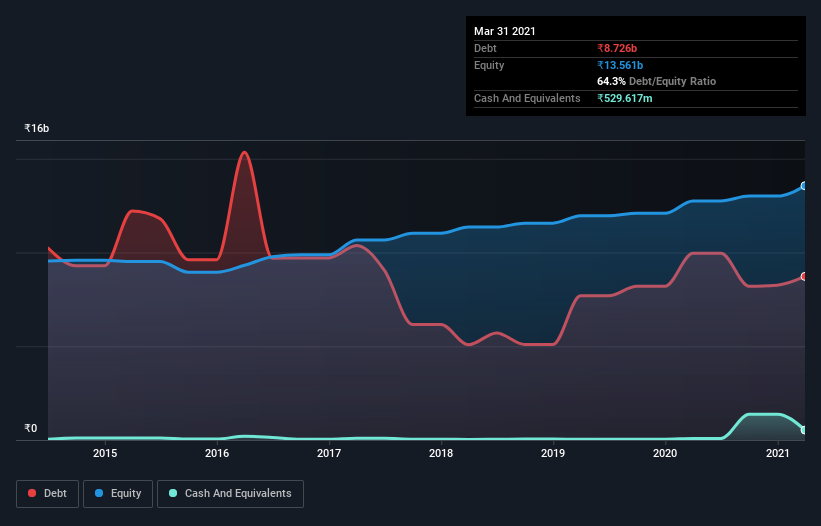
David Iben put it well when he said, 'Volatility is not a risk we care about. What we care about is avoiding the permanent loss of capital.' So it seems the smart money knows that debt - which is usually involved in bankruptcies - is a very important factor, when you assess how risky a company is. As with many other companies Bannari Amman Sugars Limited (NSE:BANARISUG) makes use of debt. But is this debt a concern to shareholders?
When Is Debt A Problem?
Debt assists a business until the business has trouble paying it off, either with new capital or with free cash flow. In the worst case scenario, a company can go bankrupt if it cannot pay its creditors. However, a more common (but still painful) scenario is that it has to raise new equity capital at a low price, thus permanently diluting shareholders. By replacing dilution, though, debt can be an extremely good tool for businesses that need capital to invest in growth at high rates of return. The first step when considering a company's debt levels is to consider its cash and debt together.
View our latest analysis for Bannari Amman Sugars
How Much Debt Does Bannari Amman Sugars Carry?
You can click the graphic below for the historical numbers, but it shows that Bannari Amman Sugars had ₹8.72b of debt in March 2021, down from ₹9.96b, one year before. However, it also had ₹529.6m in cash, and so its net debt is ₹8.19b.

How Strong Is Bannari Amman Sugars' Balance Sheet?
The latest balance sheet data shows that Bannari Amman Sugars had liabilities of ₹8.43b due within a year, and liabilities of ₹1.91b falling due after that. Offsetting these obligations, it had cash of ₹529.6m as well as receivables valued at ₹1.62b due within 12 months. So its liabilities outweigh the sum of its cash and (near-term) receivables by ₹8.19b.
Bannari Amman Sugars has a market capitalization of ₹22.1b, so it could very likely raise cash to ameliorate its balance sheet, if the need arose. But it's clear that we should definitely closely examine whether it can manage its debt without dilution.
We measure a company's debt load relative to its earnings power by looking at its net debt divided by its earnings before interest, tax, depreciation, and amortization (EBITDA) and by calculating how easily its earnings before interest and tax (EBIT) cover its interest expense (interest cover). This way, we consider both the absolute quantum of the debt, as well as the interest rates paid on it.
Bannari Amman Sugars's debt is 3.9 times its EBITDA, and its EBIT cover its interest expense 3.7 times over. This suggests that while the debt levels are significant, we'd stop short of calling them problematic. Another concern for investors might be that Bannari Amman Sugars's EBIT fell 13% in the last year. If things keep going like that, handling the debt will about as easy as bundling an angry house cat into its travel box. There's no doubt that we learn most about debt from the balance sheet. But you can't view debt in total isolation; since Bannari Amman Sugars will need earnings to service that debt. So when considering debt, it's definitely worth looking at the earnings trend. Click here for an interactive snapshot.
Finally, a company can only pay off debt with cold hard cash, not accounting profits. So the logical step is to look at the proportion of that EBIT that is matched by actual free cash flow. Over the last three years, Bannari Amman Sugars saw substantial negative free cash flow, in total. While investors are no doubt expecting a reversal of that situation in due course, it clearly does mean its use of debt is more risky.
Our View
Mulling over Bannari Amman Sugars's attempt at converting EBIT to free cash flow, we're certainly not enthusiastic. Having said that, its ability to handle its total liabilities isn't such a worry. Overall, it seems to us that Bannari Amman Sugars's balance sheet is really quite a risk to the business. So we're almost as wary of this stock as a hungry kitten is about falling into its owner's fish pond: once bitten, twice shy, as they say. There's no doubt that we learn most about debt from the balance sheet. However, not all investment risk resides within the balance sheet - far from it. For example, we've discovered 3 warning signs for Bannari Amman Sugars (1 doesn't sit too well with us!) that you should be aware of before investing here.
If you're interested in investing in businesses that can grow profits without the burden of debt, then check out this free list of growing businesses that have net cash on the balance sheet.
If you’re looking to trade Bannari Amman Sugars, open an account with the lowest-cost* platform trusted by professionals, Interactive Brokers. Their clients from over 200 countries and territories trade stocks, options, futures, forex, bonds and funds worldwide from a single integrated account. Promoted
Valuation is complex, but we're here to simplify it.
Discover if Bannari Amman Sugars might be undervalued or overvalued with our detailed analysis, featuring fair value estimates, potential risks, dividends, insider trades, and its financial condition.
Access Free AnalysisThis article by Simply Wall St is general in nature. It does not constitute a recommendation to buy or sell any stock, and does not take account of your objectives, or your financial situation. We aim to bring you long-term focused analysis driven by fundamental data. Note that our analysis may not factor in the latest price-sensitive company announcements or qualitative material. Simply Wall St has no position in any stocks mentioned.
*Interactive Brokers Rated Lowest Cost Broker by StockBrokers.com Annual Online Review 2020
Have feedback on this article? Concerned about the content? Get in touch with us directly. Alternatively, email editorial-team (at) simplywallst.com.
About NSEI:BANARISUG
Bannari Amman Sugars
Engages in the manufacture and sale of sugar in India.
Flawless balance sheet second-rate dividend payer.
Market Insights
Community Narratives



